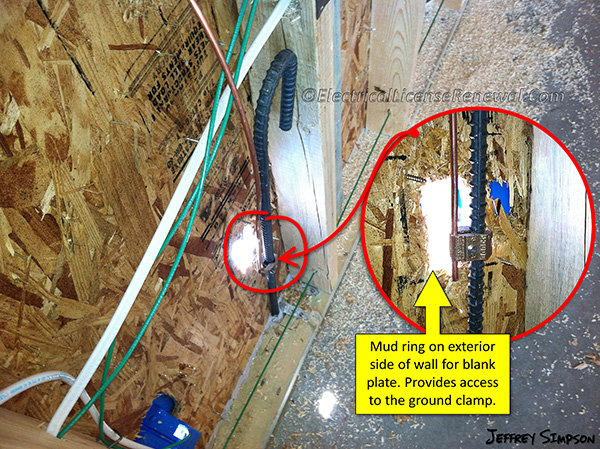250.68(C) Grounding Electrode Conductor Connections. Rebar concrete encased electrode.

Code Change Summary: The rules pertaining to rebar-type concrete encased electrodes (extending above slab) have been revised.
A concrete encased electrode can be made from bare copper wire or rebar within the footing if done in accordance with 250.52(A)(3). Part of the requirements in that section is that the concrete encased electrode must be encased by at least 2 inches of concrete and located horizontally within a portion of a concrete foundation or footing that is in direct contact with the earth or within vertical foundations or structural components or members that are in direct contact with the earth. Whether horizontal or vertical, if rebar is used as the electrode, the concrete that encases it (not the rebar) must be in contact with the earth.
When a rebar-type concrete-encased electrode is installed, it is often turned up above slab with a 90° bend into the wall cavity where a wire-type grounding electrode conductor (GEC) will be connected and run into the service panel (see image). During the 2017 revision process, concerns were raised about corrosion that can occur for some installations where the rebar electrode may emerge from the concrete encasement of the footing and be in contact with the earth before making its way into the wall cavity for connection to the wire type GEC. The 2014 NEC® code language did not specifically prohibit this from occurring.
In most cases, this is not an issue since the most common installation method is to have the rebar electrode rise up within the stem wall with full concrete encasement until it protrudes from the treated wood sill plate. For this type of installation, the rebar is never in direct contact with the earth and is not an issue.
In the 2017 NEC®, if a rebar-type concrete encased electrode emerges from the concrete and has contact with the earth, it must have corrosion protection.
Below is a preview of Article 250. See the actual NEC® text at NFPA.ORG for the complete code section. Once there, click on their link to free access to the 2017 NEC® edition of NFPA 70.
2014 Code Language:
250.68(C) Grounding Electrode Connections.
(3) A concrete-encased electrode of either the conductor type, reinforcing rod or bar installed in accordance with 250.52(A)(3) extended from its location within the concrete to an accessible location above the concrete shall be permitted.
2017 Code Language:
250.68(C) Grounding Electrode Conductor Connections.
(3) A rebar-type concrete-encased electrode installed in accordance with 250.52(A)(3) with an additional rebar section extended from its location within the concrete to an accessible location that is not subject to corrosion shall be permitted for connection of grounding electrode conductors and bonding jumpers. The rebar extension shall not be exposed to contact with the earth without corrosion protection.